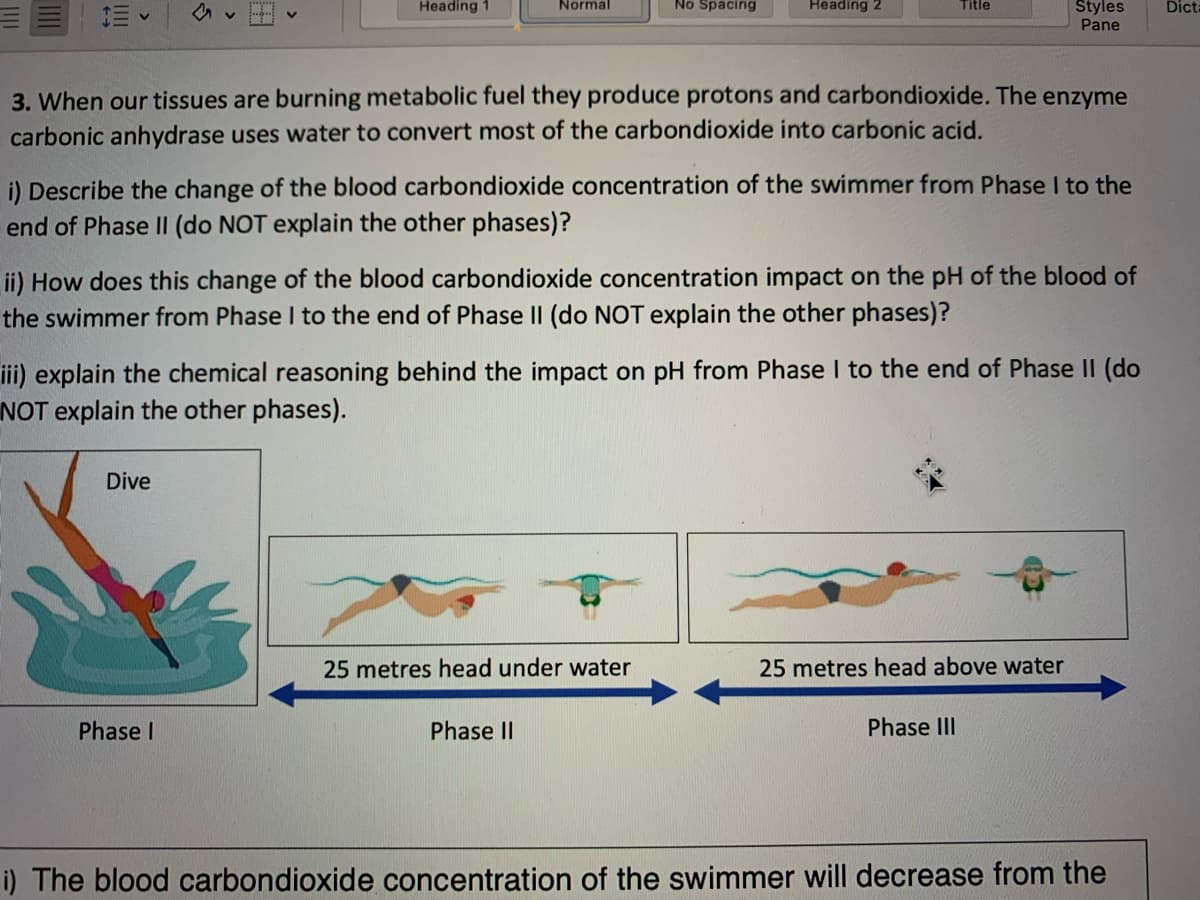3. When our tissues are burning metabolic fuel they produce protons and carbondioxide. The enzyme carbonic anhydrase uses water to convert most of the carbondioxide into carbonic acid. i) Describe the change of the blood carbondioxide concentration of the swimmer from Phase I to the end of Phase II (do NOT explain the other phases)? ii) How does this change of the blood carbondioxide concentration impact on the pH of the blood of the swimmer from Phase I to the end of Phase II (do NOT explain the other phases)? iii) explain the chemical reasoning behind the impact on pH from Phase I to the end of Phase II (do NOT explain the other phases). Dive Phase I 25 metres head under water Phase II 25 metres head above water Phase III
3. When our tissues are burning metabolic fuel they produce protons and carbondioxide. The enzyme carbonic anhydrase uses water to convert most of the carbondioxide into carbonic acid. i) Describe the change of the blood carbondioxide concentration of the swimmer from Phase I to the end of Phase II (do NOT explain the other phases)? ii) How does this change of the blood carbondioxide concentration impact on the pH of the blood of the swimmer from Phase I to the end of Phase II (do NOT explain the other phases)? iii) explain the chemical reasoning behind the impact on pH from Phase I to the end of Phase II (do NOT explain the other phases). Dive Phase I 25 metres head under water Phase II 25 metres head above water Phase III
Human Physiology: From Cells to Systems (MindTap Course List)
9th Edition
ISBN:9781285866932
Author:Lauralee Sherwood
Publisher:Lauralee Sherwood
Chapter15: Fluid And Acid-base Balance
Section: Chapter Questions
Problem 3SQE
Related questions
Question

Transcribed Image Text:Heading 1
Normal
Dive
Phase I
No Spacing
3. When our tissues are burning metabolic fuel they produce protons and carbondioxide. The enzyme
carbonic anhydrase uses water to convert most of the carbondioxide into carbonic acid.
Heading 2
i) Describe the change of the blood carbondioxide concentration of the swimmer from Phase I to the
end of Phase II (do NOT explain the other phases)?
ii) How does this change of the blood carbondioxide concentration impact on the pH of the blood of
the swimmer from Phase I to the end of Phase II (do NOT explain the other phases)?
25 metres head under water
Phase II
Title
iii) explain the chemical reasoning behind the impact on pH from Phase I to the end of Phase II (do
NOT explain the other phases).
Styles
Pane
25 metres head above water
Phase III
i) The blood carbon dioxide concentration of the swimmer will decrease from the
Dicta
Expert Solution
This question has been solved!
Explore an expertly crafted, step-by-step solution for a thorough understanding of key concepts.
Step by step
Solved in 4 steps

Recommended textbooks for you

Human Physiology: From Cells to Systems (MindTap …
Biology
ISBN:
9781285866932
Author:
Lauralee Sherwood
Publisher:
Cengage Learning

Anatomy & Physiology
Biology
ISBN:
9781938168130
Author:
Kelly A. Young, James A. Wise, Peter DeSaix, Dean H. Kruse, Brandon Poe, Eddie Johnson, Jody E. Johnson, Oksana Korol, J. Gordon Betts, Mark Womble
Publisher:
OpenStax College


Human Physiology: From Cells to Systems (MindTap …
Biology
ISBN:
9781285866932
Author:
Lauralee Sherwood
Publisher:
Cengage Learning

Anatomy & Physiology
Biology
ISBN:
9781938168130
Author:
Kelly A. Young, James A. Wise, Peter DeSaix, Dean H. Kruse, Brandon Poe, Eddie Johnson, Jody E. Johnson, Oksana Korol, J. Gordon Betts, Mark Womble
Publisher:
OpenStax College


Cardiopulmonary Anatomy & Physiology
Biology
ISBN:
9781337794909
Author:
Des Jardins, Terry.
Publisher:
Cengage Learning,

Biology 2e
Biology
ISBN:
9781947172517
Author:
Matthew Douglas, Jung Choi, Mary Ann Clark
Publisher:
OpenStax
